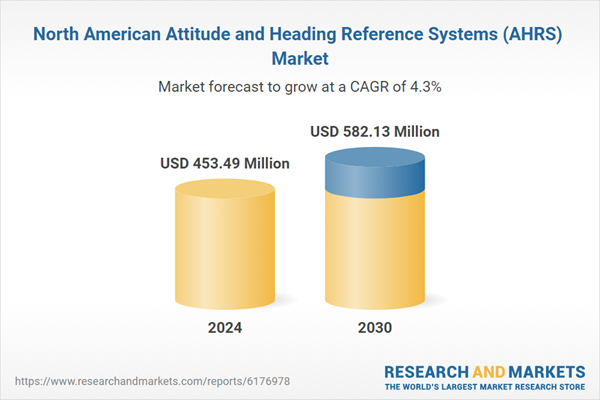Speak directly to the analyst to clarify any post sales queries you may have.
10% Free customizationThis report comes with 10% free customization, enabling you to add data that meets your specific business needs.
Increasing integration of AHRS with advanced avionics, autopilot systems, and unmanned aerial vehicles is enhancing operational efficiency, situational awareness, and safety in complex flight environments. Technological trends such as miniaturization, improved sensor fusion, and real-time data processing are making AHRS more compact, energy-efficient, and precise, expanding their applications beyond traditional aircraft to drones, helicopters, and spacecraft. Opportunities lie in the development of low-cost, high-performance systems for commercial aviation, emerging urban air mobility platforms, and autonomous aerial solutions, which require highly accurate orientation and navigation data.
Market Drivers
Rising Demand for Precise Navigation Systems
The growing need for accurate and reliable navigation in aviation, defense, and unmanned aerial platforms is a primary driver for AHRS adoption. Modern aircraft and drones operate in increasingly complex environments that require precise orientation, attitude, and heading data to ensure safety and efficiency. AHRS provides critical input to autopilot systems, flight management systems, and advanced avionics, enabling smoother maneuvering, reduced pilot workload, and enhanced situational awareness. The demand for high-precision navigation is not limited to traditional aircraft; emerging sectors such as urban air mobility, autonomous cargo drones, and high-altitude surveillance platforms rely heavily on AHRS to maintain operational stability in dynamic airspaces. The increasing adoption of unmanned aerial systems for commercial applications, such as logistics, agriculture, and inspection, further emphasizes the importance of compact, lightweight, and highly accurate AHRS solutions.Key Market Challenges
High Development and Integration Costs
Developing high-precision AHRS involves substantial research, engineering, and manufacturing investments, making cost a significant market challenge. Advanced sensor technologies, including gyroscopes, accelerometers, and magnetometers, must be engineered to meet stringent accuracy and reliability requirements, which increases development expenses. Integrating AHRS into existing aircraft or drone platforms often requires extensive software, calibration, and testing efforts, adding further financial and operational burden for manufacturers and operators. High-cost barriers can limit adoption in cost-sensitive markets such as commercial drones, small aircraft, and training platforms, where low-cost alternatives may suffice for basic navigation needs.Key Market Trends
Miniaturization and Lightweight Designs
Miniaturization and lightweight design of AHRS units are transforming the market, enabling integration into smaller aircraft, drones, and autonomous systems. Smaller, lighter AHRS reduce payload and energy consumption, which is particularly critical for unmanned aerial vehicles and urban air mobility platforms. Advances in MEMS (Micro-Electro-Mechanical Systems) sensors, compact gyroscopes, and integrated microprocessors allow manufacturers to maintain high accuracy while drastically reducing size. Compact AHRS units also facilitate modular avionics systems, enabling seamless upgrades and retrofits across multiple platforms. The trend toward miniaturization supports increased adoption in sectors with strict weight and space limitations, including inspection drones, delivery UAVs, and high-altitude research aircraft.Key Market Players
- Aeron Systems Private Limited
- Bell Helicopter
- Bestech Australia
- Collins Aerospace (a Raytheon Technologies company)
- CTi Sensors
- Honeywell International Inc.
- Ixblue, Inc.
- KVH Industries, Inc.
- L3Harris Technologies, Inc.
- Northrop Grumman Corporation
Report Scope:
In this report, North America Attitude and Heading Reference Systems (AHRS) Market has been segmented into the following categories, in addition to the industry trends which have also been detailed below:North America Attitude and Heading Reference Systems (AHRS) Market, By Type:
- Conventional attitude and heading reference systems
- Air data attitude and heading reference systems
- GPS-aided attitude and heading reference systems
North America Attitude and Heading Reference Systems (AHRS) Market, By End User:
- Commercial
- Military
North America Attitude and Heading Reference Systems (AHRS) Market, By Component:
- Inertial sensing unit
- Magnetic sensing unit
- Digital processing unit
North America Attitude and Heading Reference Systems (AHRS) Market, By Country:
- United States
- Canada
- Mexico
Competitive Landscape
Company Profiles: Detailed analysis of the major companies present in North America Attitude and Heading Reference Systems (AHRS) Market.Available Customizations:
With the given market data, the publisher offers customizations according to the company’s specific needs. The following customization options are available for the report.Company Information
- Detailed analysis and profiling of additional market players (up to five).
This product will be delivered within 1-3 business days.
Table of Contents
Companies Mentioned
- Aeron Systems Private Limited
- Bell Helicopter
- Bestech Australia
- Collins Aerospace (a Raytheon Technologies company)
- CTi Sensors
- Honeywell International Inc.
- Ixblue, Inc.
- KVH Industries, Inc.
- L3Harris Technologies, Inc.
- Northrop Grumman Corporation
Table Information
| Report Attribute | Details |
|---|---|
| No. of Pages | 135 |
| Published | September 2025 |
| Forecast Period | 2024 - 2030 |
| Estimated Market Value ( USD | $ 453.49 Million |
| Forecasted Market Value ( USD | $ 582.13 Million |
| Compound Annual Growth Rate | 4.2% |
| Regions Covered | North America |
| No. of Companies Mentioned | 10 |









